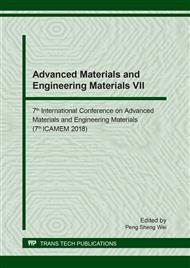p.483
p.491
p.499
p.508
p.513
p.518
p.523
p.528
p.533
Evaluation on Roles of Activated Silicon and Aluminum Oxides for Formation of Geopolymer from Red Mud and Silica Fume
Abstract:
In this study, the alkaline solutions (NaOH) with concentration from 1M to 10M, red mud (RM) and silica fume (SF) were used as reactors in geopolymer reactions. RM contains 7.40% SiO2 and 13.65% Al2O3, SF has 94.50% SiO2, but only the activated oxides can participate into the geopolymer reactions. The activity of the oxides was investigated by measuring the dissolution of RM and SF in different concentrations of NaOH. Characteristics of the geopolymer samples were tested for compressive strength and softening-coefficient, its microstructure was analyzed by using X – ray diffraction (XRD). The experimental results were indicated that activated SiO2 is the highest exist in SF. In the structure of geopolymers, the silica can be bonded directly to each other (Si-Si) or linked through “most” oxygen (Si-O-Si) to form independent polymer chains, while aluminum themselves cannot create independent polymer chains, it only can be replaced the Si atomic in Si-O-Si polymer chains (Si-O-Al), instead.
Info:
Periodical:
Pages:
513-517
Citation:
Online since:
August 2018
Keywords:
Price:
Сopyright:
© 2018 Trans Tech Publications Ltd. All Rights Reserved
Share:
Citation:


